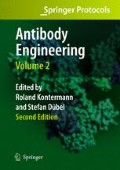Abstract
The intrabody approach is a gene-based technology developed to neutralize or modify the function of intracellular and extracellular target antigens. Since intrabodies can potentially target all different multiple isoforms of a protein, they can act as therapeutic molecules for the treatment of viral pathologies, cancer, and misfolding diseases. This chapter provides protocols for application of intrabodies in mammalian cells. We describe all the steps to express intrabodies in different subcellular compartments and to analyze the biochemical properties of scFv fragments and their intracellular distribution. We focus on protocols to study the antigen–intrabody complex in the secretory compartment and to analyze the effects of intrabody expression on membrane target protein.
Access this chapter
Tax calculation will be finalised at checkout
Purchases are for personal use only
References
Aguzzi A, Baumann F, Bremer J (2008) The prion’s elusive reason for being. Annu Rev Neurosci 31:439–477
Biocca S, Neuberger MS, Cattaneo A (1990) Expression and targeting of intracellular antibodies in mammalian cells. EMBO J 9:101–108
Biocca S, Ruberti F, Tafani M, Pierandrei-Amaldi P, Cattaneo A (1995) Redox state of single chain Fv fragments targeted to the endoplasmic reticulum, cytosol and mithocondria. Biotechnology 13:1110–1115
Böldicke T (2007) Blocking translocation of cell surface molecules from the ER to the cell surface by intracellular antibodies targeted to the ER. J Cell Mol Med 11:54–70
Cardinale A, Biocca S (2008) The potential of intracellular antibodies for therapeutic targeting of protein-misfolding diseases. Trends Mol Med 14:373–380
Cardinale A, Filesi I, Biocca S (2001) Aggresome formation by anti-Ras intracellular scFv fragments. The fate of the antigen–antibody complex. Eur J Biochem 268:268–277
Cardinale A, Filesi I, Mattei S, Biocca S (2004) Intracellular targeting and functional analysis of single-chain Fv fragments in mammalian cells. Methods 34:171–178
Cardinale A, Filesi I, Vetrugno V, Pocchiari M, Sy MS, Biocca S (2005) Trapping prion protein in the endoplasmic reticulum impairs PrPC maturation and prevents PrPSc accumulation. J Biol Chem 280:685–694
Cattaneo A, Biocca S (1997) Intracellular antibodies: development and applications. Springer, Berlin
Cattaneo A, Biocca S (1999) The selection of intracellular antibodies. Trends Biotechnol 17:115–121
Filesi I, Cardinale A, Mattei S, Biocca S (2007) Selective re-routing of prion protein to proteasomes and alteration of its vesicular secretion prevent PrP(Sc) formation. J Neurochem 101:1516–1526
Griffin H, Elston R, Jackson D, Ansell K, Coleman M, Winter G, Doorbar J (2006) Inhibition of papillomavirus protein function in cervical cancer cells by intrabody targeting. J Mol Biol 355:360–378
Jendreyko N, Popkov M, Rader C, Barbas CF 3rd (2005) Phenotypic knockout of VEGF-R2 and Tie-2 with an intradiabody reduces tumor growth and angiogenesis in vivo. Proc Natl Acad Sci USA 102:8293–8298
Li R, Liu T, Wong BS, Pan T, Morillas M, Swietnicki W, O’Rourke K, Gambetti P, Surewicz WK, Sy MS (2000) Identification of an epitope in the C terminus of normal prion protein whose expression is modulated by binding events in the N terminus. J Mol Biol 301:567–573
Lo AS, Zhu Q, Marasco WA (2008) Intracellular antibodies (intrabodies) and their therapeutic potential. Handb Exp Pharmacol 181:343–373
Persic L, Righi M, Roberts A, Hoogenboom HR, Cattaneo A, Bradbury A (1997a) Targeting vectors for intracellular immunization. Gene 187:1–8
Persic L, Righi M, Roberts A, Hoogenboom HR, Cattaneo A, Bradbury A (1997b) An integrated vector system for the eukaryotic expression of antibodies or their fragments after selection from phage display libraries. Gene 187:9–18
Prusiner SB (1998) Prions. Proc Natl Acad Sci USA 95:13363–13383
Rubenstein R, Carp RI, Callahan SM (1984) In vitro replication of scrapie agent in a neuronal model: infection of PC12 cells. J Gen Virol 65:2191–2198
Rubenstein R, Scalici CL, Papini MC, Callahan SM, Carp RI (1990) Further characterization of scrapie replication in PC12 cells. J Gen Virol 71:825–831
Tanaka T, Williams RL, Rabbitts TH (2007) Tumour prevention by a single antibody domain targeting the interaction of signal transduction proteins with RAS. EMBO J 26:3250–3259
Vetrugno V, Cardinale A, Filesi I, Mattei S, Sy MS, Pocchiari M, Biocca S (2005) KDEL-tagged anti-prion intrabodies impair PrP lysosomal degradation and inhibit scrapie infectivity. Biochem Biophys Res Commun 338:1791–1797
Wang CE, Zhou H, McGuire JR, Cerullo V, Lee B, Li SH, Li XJ (2008) Suppression of neuropil aggregates and neurological symptoms by an intracellular antibody implicates the cytoplasmic toxicity of mutant huntingtin. J Cell Biol 181:803–816
Williams BR, Zhu Z (2006) Intrabody-based approaches to cancer therapy: status and prospects. Curr Med Chem 13:1473–1480
Zdoroveac A, Doebis C, Laube H, Brösel S, Schmitt-Knosalla I, Volk HD, Seifert M (2008) Modulation of graft arteriosclerosis in a rat carotid transplantation model. J Surg Res 145:161–169
Author information
Authors and Affiliations
Corresponding author
Editor information
Editors and Affiliations
Rights and permissions
Copyright information
© 2010 Springer-Verlag Berlin Heidelberg
About this protocol
Cite this protocol
Cardinale, A., Biocca, S. (2010). Expressing Intrabodies in Mammalian Cells. In: Kontermann, R., Dübel, S. (eds) Antibody Engineering. Springer Protocols Handbooks. Springer, Berlin, Heidelberg. https://doi.org/10.1007/978-3-642-01147-4_12
Download citation
DOI: https://doi.org/10.1007/978-3-642-01147-4_12
Publisher Name: Springer, Berlin, Heidelberg
Print ISBN: 978-3-642-01146-7
Online ISBN: 978-3-642-01147-4
eBook Packages: Springer Protocols

